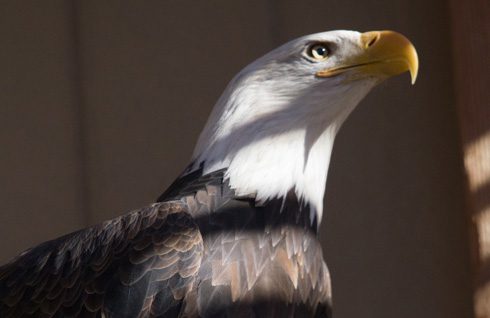
After a career in the business world, Iowa Tribe member and Perkins resident Victor Roubidoux decided to drastically alter his life’s flight plan.
“In about 2002, I saw an article about a rehabilitation center in New Mexico for birds, and I thought it would be a great project for Oklahoma tribes because of the way [their] culture reveres the eagle,” Roubidoux recalls. “So I had the idea, but there was no money available.”
In order to raise funds and generate interest in the project, Roubidoux headed to Washington, D.C., to speak with legislators.
“I talked to as many people as I could, knocking on doors one after another. Then in 2004, the tribe called me and said they had a grant to open a rehab center, and they asked me if I wanted to run it,” Roubidoux says.
During this time, Roubidoux received training from various organizations, including the Birds of Prey Foundation headquartered in Colorado. Roubidoux had no previous experience working with birds.
“I told the trainer [at the Birds of Prey Foundation] that she should treat me like a blank piece of paper,” Roubidoux says. “She told me she would take care of that. At that point, I wasn’t completely sure that I wanted to work with birds, but after only two weeks, that’s when it dawned on me that this was what I wanted to do. All you have to do is spend a little time around the birds and they get you.”

Roubidoux says he enjoys working with birds of prey because they are “magnificent and intelligent creatures,” but they also hold great significance culturally.
“Tribes might have different cultures, languages, dances and everything else, but they all revere the eagle. We believe the eagle is the only one who has seen the face of the creator. They have also been good to us through the use of their feathers. I couldn’t believe eagles were being euthanized, so now it’s our time to take care of them,” Roubidoux says.
The center’s name, the Grey Snow Eagle House, comes from the name of Roubidoux’s tribe. In the Iowa language, the name of the tribe, Baxoje, means “people of the gray snow.”
The eagle house, located in Perkins, now includes three 100-foot enclosures, two enclosures 18 feet tall and 25 feet wide, and another shorter enclosure for handicapped birds. The center also has a 150-foot-long straightaway designed for monitored rehab flight, Roubidoux says, where recovering birds can exercise to build up their wings and muscles after injuries.
When they first arrive, the injured birds are taken to the intensive care facility on the property. They come to Perkins from all over the country.
“We’ve had birds from Connecticut, Wisconsin, Michigan, Iowa, Arkansas, Nebraska, Utah, Colorado, Idaho and Oregon. These were all birds that were going to be euthanized; we go pick them up and bring them here,” Roubidoux says. “With the Oklahoma birds here, those are the ones we are trying to get well so they can get back in the wild. The vet makes the determination whether they are ready or not.”

The most common injury Roubidoux and staff see is injured wings. This occurs more often in winter when food is scarcer.
“Sometimes they will go after road kill and gorge themselves on it, making their bodies so much heavier that they can’t get the elevation they need to in order to take off,” Roubidoux says.
After an initial diagnosis, the birds are carefully monitored.
“We have nine staff members and four interns. In addition to cleaning and prepping food and general maintenance, most of the staff’s time is spent monitoring the birds,” Roubidoux says.
When certain birds are deemed ready to return to the wild, Roubidoux says the feeling is amazing.
“It feels like we are doing our jobs right when we get to the part of getting them where they belong. We try to release them back in the area where they were found, or if they are juveniles, we try to make sure they’re around other eagles,” Roubidoux says.
The Grey Snow Eagle House is currently home to 48 eagles and several varieties of others birds used for educational purposes, including the Mississippi kite, Harlan hawk, barn owl, red-tailed hawk and peregrine falcon. In addition to rehabilitating birds and taking care of those unable to be re-released, the center emphasizes educating the public.
“We want to make sure that school kids know about eagles, what they mean to the tribes, and to our countries and others that use the eagle as a symbol of freedom,” Roubidoux says. “It’s so important to teach them about the balance we maintain with wildlife. Our next big push here is educating the public to ensure the safety of these birds in the future.”
Looking forward, Roubidoux says he hopes to increase the number of birds the center can take in. Right now, Grey Snow Eagle House is about “as far as they can go” with current space, which is permitted for 56 birds, but Roubidoux would like to increase the number to 70. The Grey Snow Eagle House is also working with Oklahoma State University on a genome project with golden eagles.
“Part of the project includes finding out how turbines and other man-made structures are affecting the birds and figuring out the best ways we can move forward with conservation,” Roubidoux says.
Compared to his previous occupation, Roubidoux says he has found peace in his role as a caretaker and defender of eagles.
“Dealing with birds is a lot different than dealing with people. It’s less stressful, and they’re easier to work with,” Roubidoux says, laughing. “I get such a sense of satisfaction in seeing them get well. Getting to know them and their personalities and working with them is such a privilege and an honor.”


























